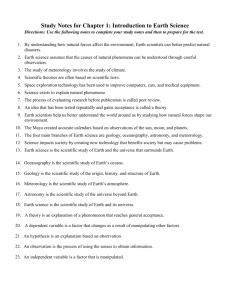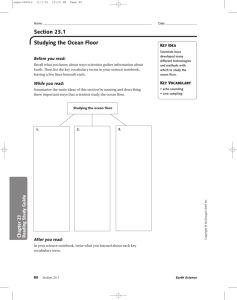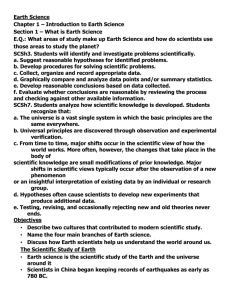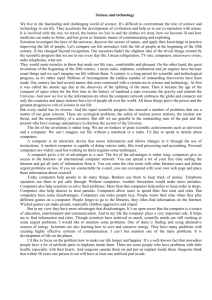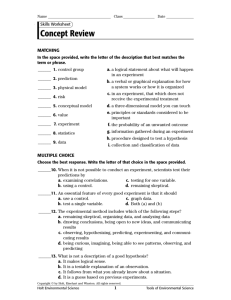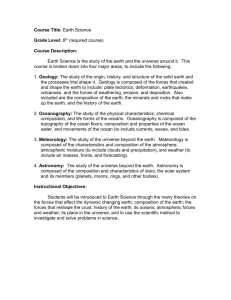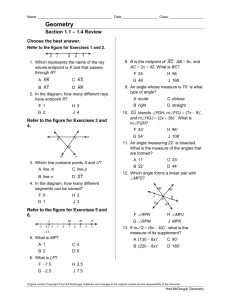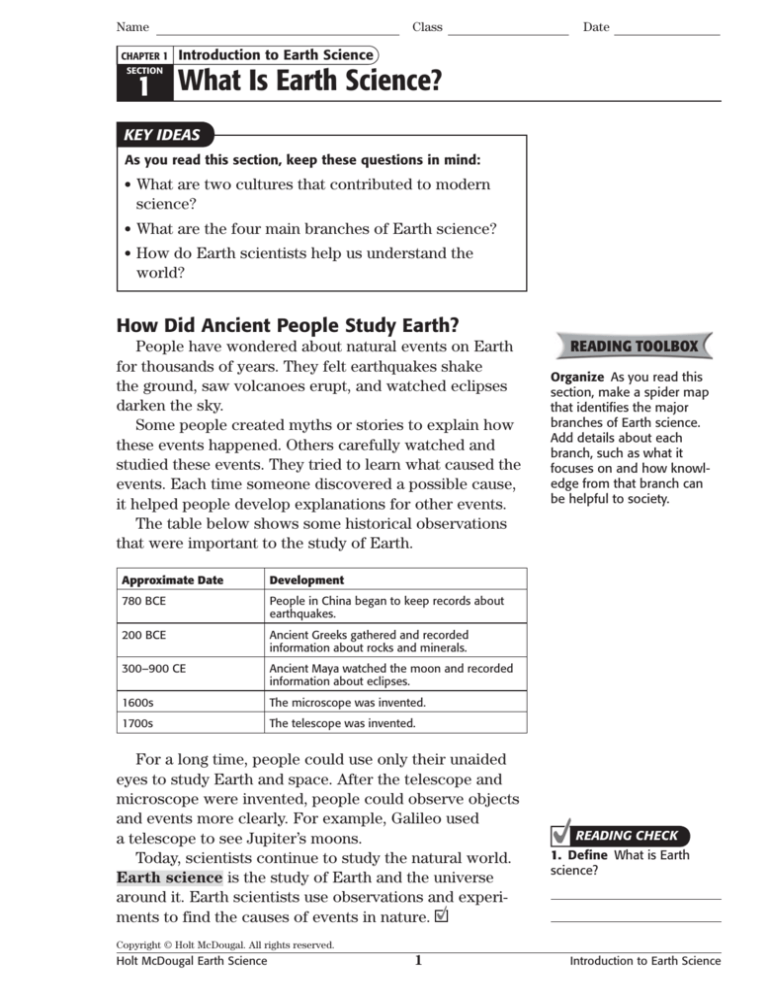
Name
CHAPTER 1
Class
Date
Introduction to Earth Science
SECTION
1 What Is Earth Science?
KEY IDEAS
As you read this section, keep these questions in mind:
• What are two cultures that contributed to modern
science?
• What are the four main branches of Earth science?
• How do Earth scientists help us understand the
world?
How Did Ancient People Study Earth?
People have wondered about natural events on Earth
for thousands of years. They felt earthquakes shake
the ground, saw volcanoes erupt, and watched eclipses
darken the sky.
Some people created myths or stories to explain how
these events happened. Others carefully watched and
studied these events. They tried to learn what caused the
events. Each time someone discovered a possible cause,
it helped people develop explanations for other events.
The table below shows some historical observations
that were important to the study of Earth.
Approximate Date
Development
780 BCE
People in China began to keep records about
earthquakes.
200 BCE
Ancient Greeks gathered and recorded
information about rocks and minerals.
300–900 CE
Ancient Maya watched the moon and recorded
information about eclipses.
1600s
The microscope was invented.
1700s
The telescope was invented.
For a long time, people could use only their unaided
eyes to study Earth and space. After the telescope and
microscope were invented, people could observe objects
and events more clearly. For example, Galileo used
a telescope to see Jupiter’s moons.
Today, scientists continue to study the natural world.
Earth science is the study of Earth and the universe
around it. Earth scientists use observations and experiments to find the causes of events in nature.
READING TOOLBOX
Organize As you read this
section, make a spider map
that identifies the major
branches of Earth science.
Add details about each
branch, such as what it
focuses on and how knowledge from that branch can
be helpful to society.
READING CHECK
1. Define What is Earth
science?
Copyright © Holt McDougal. All rights reserved.
Holt McDougal Earth Science
1
Introduction to Earth Science
Name
SECTION 1
Class
Date
What Is Earth Science? continued
What Are the Main Branches of Earth Science?
Most Earth scientists focus their work on one of these
four main branches:
READING CHECK
2. List What are the four
main branches of Earth
science?
•
•
•
•
Geology – the study of rocks and soil
Oceanography – the study of Earth’s oceans
Meteorology – the study of Earth’s atmosphere
Astronomy – the study of the universe beyond Earth
GEOLOGY
Geology is the study of the rocks and soil on Earth.
Geologists may
• search for natural resources near Earth’s surface
• study forces within Earth to predict when earthquakes
will happen or volcanoes will erupt
• study fossils to learn about Earth’s history
Talk About It
Connect Choose the branch
of Earth science you think
is most interesting. With a
partner, discuss what interests you about this branch of
Earth science.
OCEANOGRAPHY
Oceanography is the study of Earth’s oceans. Some
oceanographers study waves, tides, or ocean currents.
Others explore the floor of the ocean. These scientists
might find useful minerals, or they might discover clues
about the history of Earth.
METEOROLOGY
Meteorology is the study of Earth’s atmosphere.
Meteorologists study the atmosphere to understand
weather patterns. Many meteorologists measure wind
speed, temperature, and rainfall. They use those measurements to create maps. Other meteorologists use the maps
to predict future weather.
Some meteorologists study climate. Climate is the
weather patterns in one place over a long span of time.
Critical Thinking
3. Infer In which branch of
Earth science would a
scientist most likely study
how a mountain chain
formed?
ASTRONOMY
Astronomy is the study of the universe beyond Earth.
It is one of the oldest branches of Earth science. Today,
astronomers use technology to learn about the universe.
For example, spacesuits are a technology that allows
astronauts to explore space. Telescopes are a technology
that lets humans see and study other galaxies.
Copyright © Holt McDougal. All rights reserved.
Holt McDougal Earth Science
2
Introduction to Earth Science
Name
SECTION 1
Class
Date
What Is Earth Science? continued
What Is Environmental Science?
Some Earth scientists study the ways that humans
interact with their environment. This field is called environmental science. Environmental scientists use information from many sciences, including biology, Earth
science, and social sciences. Environmental scientists
try to understand how human actions affect the environment. They also try to solve problems that human actions
cause.
Why Is Earth Science Important?
Understanding how forces on Earth and in the atmosphere work can save people’s lives. For example, geologists may alert people to leave an area if a volcano is
about to erupt. Meteorologists may predict the path of
a dangerous storm. Their predictions can help people
prepare properly.
These meteorologists are
risking their lives to study
tornadoes. The information
they collect may help other
scientists predict when and
where other tornadoes
might happen.
READING CHECK
4. Identify What are three
fields that contribute to
environmental science?
Talk About It
In a small group, talk about
events that you have heard
about or read about that are
related to Earth science. For
example, you might discuss
a recent earthquake or
tornado. Talk about when
and where the event
happened and about any
damage the event caused.
Earth scientists can also help us understand our place
in the universe. Astronomers study other galaxies to try
to understand how the universe formed. Geologists study
rock layers to discover clues about Earth’s history.
Earth scientists work to find and gather the resources
people need. People use resources from Earth every day.
The fuel in a jet, the metal in electric wires, and the ink
on this page are made from Earth’s resources. Earth
scientists also look for ways to use resources wisely.
Copyright © Holt McDougal. All rights reserved.
Holt McDougal Earth Science
3
Introduction to Earth Science
Name
Class
Date
Section 1 Review
SECTION VOCABULARY
astronomy the scientific study of the universe
Earth science the scientific study of Earth and
the universe around it
geology the scientific study of the origin,
history, and structure of Earth and the
processes that shape Earth
meteorology the scientific study of Earth’s
atmosphere, especially in relation to weather
and climate
oceanography the scientific study of the ocean,
including the properties and movements of
ocean water, the characteristics of the ocean
floor, and the organisms that live in the ocean
1. Summarize Fill in the missing information in the table below.
Branch of Earth Science Focus of Study
rock and soil
Areas of Study
1. search for natural resources near Earth’s surface
2. study Earth’s forces to predict earthquakes or volcanoes
3.
1. study waves, tides, or ocean currents
2.
Meteorology
1. measure wind speed, temperature, and rainfall
2. use maps to predict future weather
3.
study the sun, moon, planets, and the rest of the universe
2. Discuss Name one ancient culture that studied Earth. How were the activities of
this culture similar to the activities of Earth scientists today?
3. Identify Relationships What is the relationship between Earth science and
environmental science?
4. Explain How has technology affected the work of astronomers?
Copyright © Holt McDougal. All rights reserved.
Holt McDougal Earth Science
4
Introduction to Earth Science

